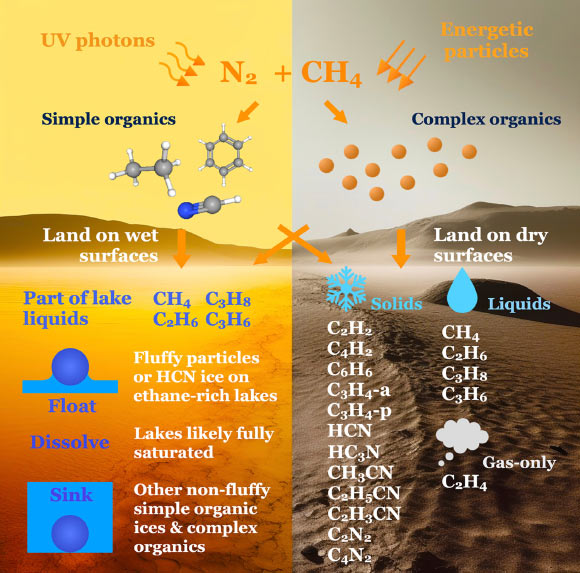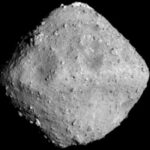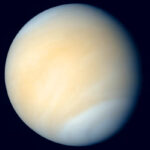Titan, the largest moon of Saturn, has a unique atmosphere that transforms simple gases like methane and nitrogen into more complex organic compounds. In a new study, planetary researchers at the University of Texas at San Antonio, the University of California Santa Cruz and Johns Hopkins University explored what happens to these organic compounds when they reach Titan’s surface. They found that most molecules, including all nitriles, triple-bonded hydrocarbons, and benzene, would land as solids. They also examined whether floating rafts can explain a mysterious feature on Titan’s lakes known as the ‘magic islands.’ By looking at how long the materials will float for each scenario, the authors suggest that the magic islands might be made of large chunks of porous organic solids.
Ligeia Mare and high-resolution Cassini observations of the region. The Magic Island (red circle) is observed at 78° N, 123° E and not seen in any of the other images. Green rectangle indicates the extent of the high-resolution images, and green ovals correspond to the area circled in red. White arrows in radar images indicate the radar illumination direction. Image credit: Hofgartner et al.
A hazy orange atmosphere 50% thicker than Earth’s and rich in methane and other organic molecules blankets Titan.
Its surface is covered with dark dunes of organic material and seas of liquid methane and ethane.
Stranger yet are what appear in radar imagery as shifting bright spots on the seas’ surfaces that can last a few hours to several weeks or more.
Planetary scientists first spotted these ephemeral ‘magic islands’ in 2014 with the NASA/ESA Cassini-Huygens mission and have since been trying to figure out what they are.
Previous studies suggested they could be phantom islands caused by waves or real islands made of suspended solids, floating solids, or bubbles of nitrogen gas.
University of Texas at San Antonio researcher Xinting Yu and colleagues wondered if a closer look at the relationship between Titan’s atmosphere, liquid lakes, and the solid materials deposited on the moon’s surface could reveal the cause of these mysterious islands.
“I wanted to investigate whether the magic islands could actually be organics floating on the surface, like pumice that can float on water here on Earth before finally sinking,” Dr. Yu said.

Summary of the fate of simple and complex organics on Titan’s surface. Image credit: Yu et al., doi: 10.1029/2023GL106156.
The authors first investigated whether Titan’s organic solids would simply dissolve in the moon’s methane lakes.
Because the lakes are already saturated with organic particles, they determined that the falling solids would not dissolve when they reached the liquid.
“For us to see the magic islands, they can’t just float for a second and then sink. They have to float for some time, but not for forever, either,” Dr. Yu said.
The models suggested that most of the frozen solids were too dense and the surface tension too low to create Titan’s magic islands unless the clumps were porous like swiss cheese.
If the icy clumps were large enough and had the right ratio of holes and narrow tubes, the liquid methane could seep in slowly enough that the clumps could linger at the surface.
The modeling suggested individual clumps are likely too small to float by themselves.
But if enough clumps massed together near the shore, larger pieces could break off and float away, similar to how glaciers calve on Earth.
With a combination of a bigger size and the right porosity, these organic glaciers could explain the magic island phenomenon.
In addition to the magic islands, a thin layer of frozen solids coating Titan’s seas and lakes could explain the liquid bodies’ unusual smoothness.
“In our theoretical examination of the fate of simple organics on Titan’s surface, we draw the following conclusions,” the researchers said.
“Most simple organics will land as solids on Titan’s surface, while methane, ethane, propane, and propene will be liquid. Ethylene will be gaseous only.”
“Simple organics may achieve buoyancy on Titan’s lake liquids through porosity-induced or capillary force-induced flotation, with porosity-induced flotation being feasible if the simple organics on Titan resemble terrestrial snow. Capillary force-induced flotation is only viable for hydrogen cyanide ice in ethane-rich lakes.”
“Porosity-induced flotation of millimeter-sized and larger particles is the only plausible mechanism for floating solids to explain Titan’s transient radar-bright magic islands. Shorter or longer timescales for other flotation mechanisms do not align with the observations.”
The findings are published in the journal Geophysical Research Letters.
_____
Xinting Yu et al. 2024. The Fate of Simple Organics on Titan’s Surface: A Theoretical Perspective. Geophysical Research Letters 51 (1): e2023GL106156; doi: 10.1029/2023GL106156




